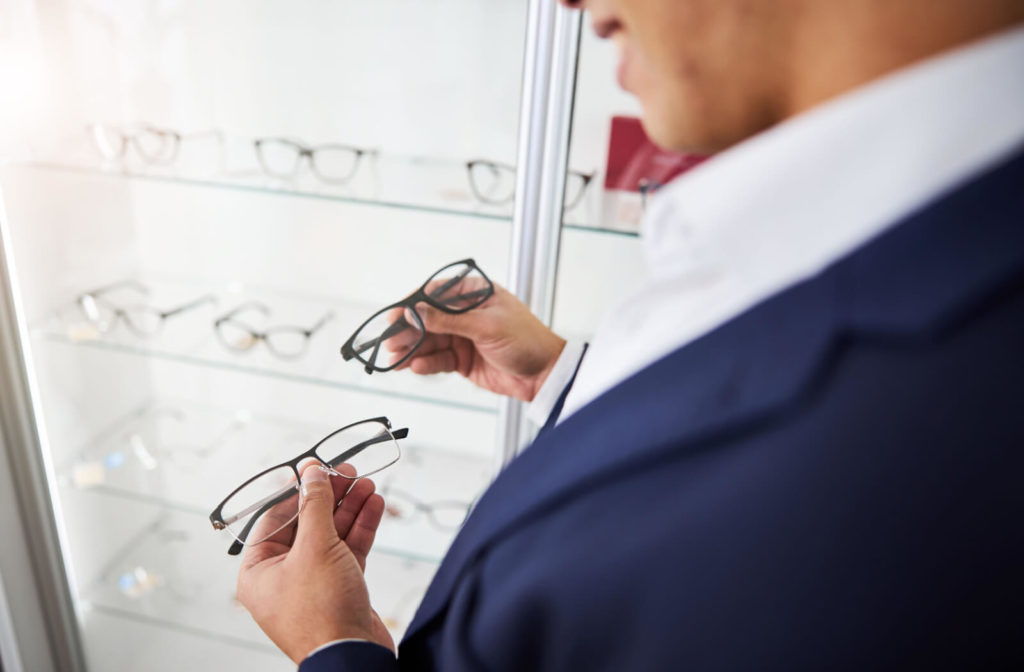Navigating the world of corrective eyewear can often feel like traveling without a map, especially as we age and our visual needs shift. As a person with presbyopia, the choice between bifocal glasses and progressive lenses can be a pivotal one.
This decision can significantly impact your comfort, clarity, and even style. Bifocal glasses contain 2 prescriptions in one lens, allowing you to go from one focal point to another with a clear dividing line within the lens. Progressive lenses do the same, but without the dividing line, allowing you to experience seamless vision as the focus gradually changes.
We will take an extensive look at the differences between these 2 popular lens options to help you find the fit for your unique needs.
Understanding Bifocal Glasses
Bifocals provide separate lenses for distance and near vision. Traditionally, bifocals have a visibly segmented lens, a near-constant reminder of their dual function. The power of the lower lens allows wearers to see objects up close, generally within arm’s reach, while the upper segment caters to an individual’s distance vision needs.
This design has been the go-to for those who don’t mind the telltale line. But do they have a place in a modern world of digital screens and variable focal lengths?
Pros & Cons of Bifocals
For some, the division in the lens may be a deal-breaker, causing visual discomfort or an adjustment period that feels never-ending. On the positive side, they are often less expensive than progressives, and for wearers with specific reading needs, they provide a no-fuss solution to near-vision tasks without the need to switch glasses.
Are You a Good Candidate for Bifocals?
If your prescription is stable and your daily routine does not involve extensive mid-range vision, bifocals could work well for you. However, if your tasks include using a computer or reading varying distances, you might find them limiting.
Exploring Progressive Lenses
Enter the more sophisticated sibling of bifocal glasses—progressive lenses. These innovative eyepieces offer a seamless transition from distance to mid-range to near vision without the need for multiple lens segments. As the name suggests, they correct all focal ranges gradually, hence the lack of any lines or sudden shifts. Progressive lenses can be customized based on your specific visual needs, dedicating more of the lens to distance vision, mid-range, or near.
The Gradual Shift
The beauty of progressive lenses lies in their ability to cater to an individual’s full visual spectrum. Unlike bifocals, progressives don’t require wearers to adjust their head position to use the different lens segments, making for a more natural and comfortable experience.
The Perks & Pitfalls of Progressives
One of the most significant advantages is the aesthetic benefit; not having a line across the lens makes them appear more like single-vision glasses. However, progressives can come with a learning curve. During the adaptation period, it may take time and patience to get used to the new vision correction, as the distortion on the sides of the lens is usually greater than in traditional lenses.
Are You a Good Candidate for Progressives?
If you lead a more versatile lifestyle that requires a broad visual range, progressives are a solid choice. They’re particularly beneficial if your work or hobbies involve frequent changes in your line of sight.
Factors to Consider When Choosing Lenses
Both bifocals and progressives offer their own sets of benefits and drawbacks. Selecting the right option means considering several personal factors that can influence the effectiveness and satisfaction with your choice.
Lifestyle & Visual Demands
Think about your daily activities—do they involve a predictable use of vision, or is there a constant swapping between near and far tasks? For example, if your work is desk-based and involves extensive computer work, you might lean toward progressives. However, if your day consists mainly of a clear division between reading and distance vision, bifocal glasses may suffice.
Comfort & Adjustment
How adaptable are you to new lenses? Each person’s comfort level with change is different. Try on each type of lens if possible, and see what feels most comfortable to you. Keep in mind that for both types of lenses there may be a bit of an adjustment period.
Prescription Specifics
The complexity of your prescription can also tip the scale. Those with more severe or complex vision correction may find better clarity with progressives, which are more customizable to individual needs.
Financial & Insurance Considerations
Cost can be a significant factor when choosing between bifocals and progressives. Check your insurance coverage and weigh it against the potential out-of-pocket expense to make an informed decision.
The Takeaway
As presbyopia leads the way to new optical challenges, understanding the choices available can make a significant difference in your day-to-day life. By considering your lifestyle, comfort, prescription needs, and insurance coverage, you can confidently choose the appropriate solution for your journey.
Remember, the actual value of any corrective eyewear lies not in its technology but in how well it integrates into your life. Take the time to try on different options, assess their performance in various settings, and consult with professionals who can guide you through the process.
In the end, your decision should be based on real-world functionality and the assurance that your eyes are getting the care they deserve. Request an appointment with us at Simcoe Optometric Clinic today to get started.



